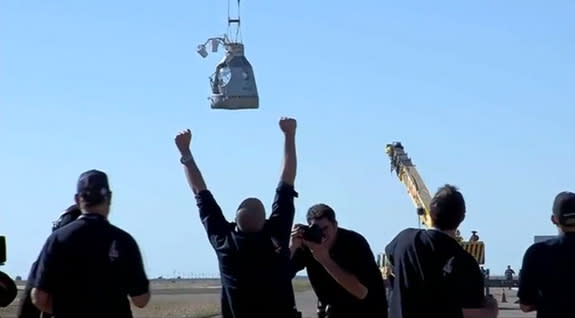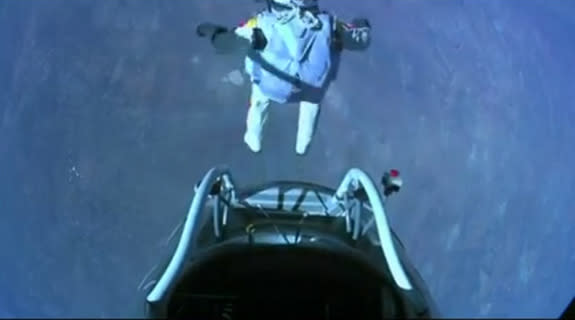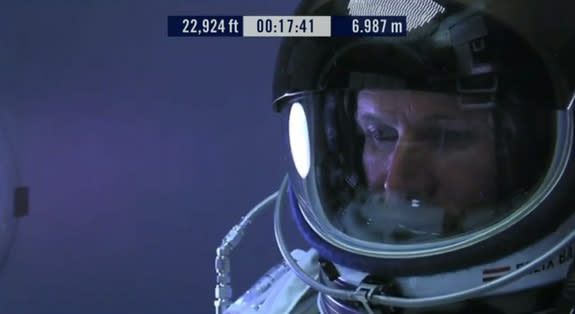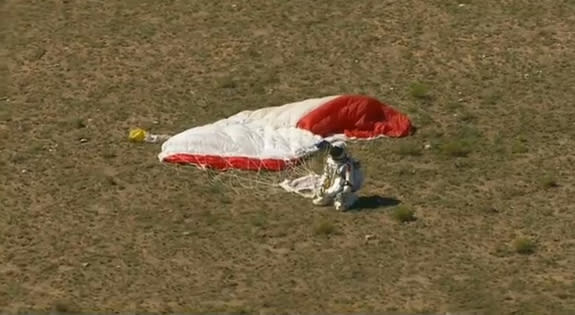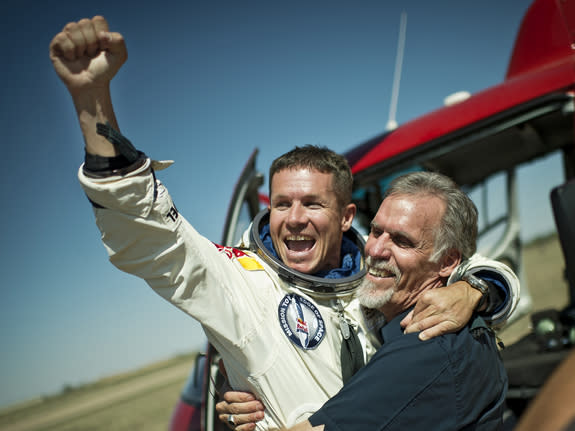World's Highest Skydive! Daredevil Makes Record-Breaking Supersonic Jump
This story was updated at 6:19 p.m. EDT.
An Austrian daredevil plummeted into the record books today (Oct. 14), breaking the mark for highest-ever skydive after leaping from a balloon more than 24 miles above Earth's surface. Add one more feat: Going supersonic.
Felix Baumgartner stepped into the void nearly 128,000 feet (39,000 meters) above southeastern New Mexico Sunday at just after 12 p.m. MT (2 p.m. ET, 1800 GMT), then landed safely on the desert floor about 20 minutes later. His harrowing plunge shattered the skydiving altitude record, which had stood for more than 50 years, and it notched a few other firsts as well.
During his freefall, for example, Baumgartner became the first skydiver ever to break the sound barrier, which is about 690 mph (1,110 kph) at such lofty heights. And this happened on a special day — today is the 65th anniversary of the first supersonic airplane flight, which was piloted by American Chuck Yeager in 1947 aboard the Bell X-1 rocket plane.
"I know the whole world is watching now, and I wish the world could see what I see," Baumgartner said just before the leap. "And sometimes you have to go up really high to see how small you really are." [Photos: Skydiver's Makes Record 24-Mile Supersonic Jump]
Preliminary results of the jump showed Baumgartner spent about 4 minutes and 20 seconds in freefall (a record without a drogue parachute). His maximum speed was 833 mph (1,342.8 kph), said Brian Utley, an air sports official watching over event.
The jump's top speed was thus Mach 1.24 — considerably faster than the speed of sound. Applause and cheers erupted in a post-jump press conference as Utley relayed the good news.
Baumgartner said he didn't feel anything different while breaking the sound barrier.
"When you're in that pressure suit, you don't feel anything. It's like being in a cast," he said.
About the only glitch during the jump was a problem with the faceplate heater in Baumgartner's helmet, which the skydiver and his Mission Control team worked on during the hours-long ascent. They ultimately decided to proceed with the jump despite the heater glitch, and later Baumgartner reported the heater was working.
While in freefall, Baumgartner went into a harrowing spin briefly, but was able to recover and go into a controlled descent. He said his visor was fogging up during the dramatic descent. After the daredevil fell toward Earth for more than four minutes, his parachute deployed and applause erupted from his Mission Control.
Roof of the sky
Baumgartner's mission — called Red Bull Stratos, and sponsored by the Red Bull energy drink company — also set the record for highest-ever manned balloon flight, officials said. Project officials touted the skydive as a "space jump," calling it a "Mission to the Edge of Space."
The officially recognized space border is actually higher, however. Most experts generally regard space to begin at an altitude of 62 miles (100 kilometers), or about 327,000 feet.
One of the many folks congratulating Baumgartner today is doubtless Joe Kittinger, who set the previous altitude mark of 102,800 feet (31,333 m) in 1960 while a captain in the U.S. Air Force. Kittinger serves as an adviser to the Red Bull Stratos mission and communicated with Baumgartner during his ascent from mission control on the ground. [Extreme Skydive From 120,000 Feet Animated]
"I couldn't have done it any better myself," Kittinger radioed Baumgartner as he descended under parachute.
The 43-year-old Baumgartner is a veteran thrill-seeker, having leapt from some of the world's tallest buildings and soared across the English Channel in freefall with the aid of a carbon wing. But he said today's historic jump should do more than just etch his name in the record books.
"Red Bull Stratos is an opportunity to gather information that could contribute to the development of life-saving measures for astronauts and pilots — and maybe for the space tourists of tomorrow," Baumgartner said in a statement before his leap. "Proving that a human can break the speed of sound in the stratosphere and return to Earth would be a step toward creating near-space bailout procedures that currently don’t exist."
Liftoff for Red Bull Stratos
Baumgartner's 55-story helium-filled balloon lifted off from Roswell, N.M. around 9:30 a.m. local time today (11:30 a.m. EDT; 1530 GMT), carrying the daredevil aloft in his custom-built 2,900-pound (1,315 kilograms) capsule.
The balloon was originally supposed to take off Monday (Oct. 8), but that launch, and another attempt Tuesday (Oct. 9), were called off because of gusting winds. Even moderate breezes can damage the enormous balloon, which is made of material 10 times thinner than a plastic sandwich bag, Red Bull Stratos officials have said.
Some of the daredevil's close friends and family — including his parents, Felix and Eva — made the trip from Austria to witness his record-breaking leap, mission officials said.
"I know he is perfectly prepared," Eva Baumgartner said in a statement before her son's jump, which he had spent five years readying for. "I am happy that he can do this; he worked hard for it. It is his childhood dream coming true."
Baumgartner worked up to today's leap in a stepwise fashion, jumping from 71,581 feet (21,818 m) this past March and then from 97,146 feet (29,610 m) on July 25.
Jonathan Clark, a former NASA flight surgeon who served as the medical officer for Baumgartner's Red Bull Stratos mission, said nothing about the skydive was simple. From the faceplate heater to Baumgartner's early spin during freefall, the challenges were always great.
"This was not an easy task," Clark said. "The world needs a hero, and today they got one."
Follow SPACE.com senior writer Mike Wall on Twitter @michaeldwall or SPACE.com @Spacedotcom. We're also on Facebook and Google+.
Photos: Daring Skydiver Makes Record 24-Mile Supersonic Jump
Space Jump: How Daredevil's Record-Breaking Supersonic Skydive Works (Infographic)
Copyright 2012 SPACE.com, a TechMediaNetwork company. All rights reserved. This material may not be published, broadcast, rewritten or redistributed.

